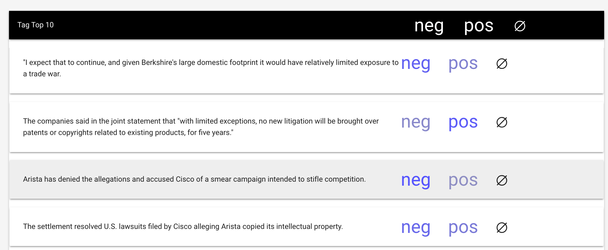Why
Tagging a dataset is done to create a set of training examples for text classification problems.
...
Facet Name- The Facet that stores the labels added by humansTag Facet Name- The Facet that stores the tags predicted by the modelLabels to use- The options for different classes, if they have not already been predicted by a model.- For example, if you have the classes "pos" and "neg", you can fill in this config option with the value "pos,neg" to tell that to the widget
Show bulk tagging controls- If selected, a black bar will appear at the top of the widget, with the option to label the top 10 examples shown with a single click.
If training and inference jobs are already set up, you will see the prediction strength for each class for each example in the project (the darker a class shows up, the more strongly the model predicts that label). At this point, you are ready to start labeling examples and training the model.
Usage
It is typically easiest to use the search bar to find good examples to tag first. Any type of search can be used along with the data labeling widget, so there are lots of clever ways of finding good examples for each class to start with. Such as:
- Simple keyword search
- Making a smartfilter
- Looking for examples where the current model is really confident already:
label_pred:CLASS>0.9
- Looking for examples where the current model is totally unsure:
label_pred:CLASS>0.45 AND label_pred:CLASS<0.55
In general, if you want to tag the examples that will have the greatest overall improvement in the quality of the model, you should look for examples where either:
...
